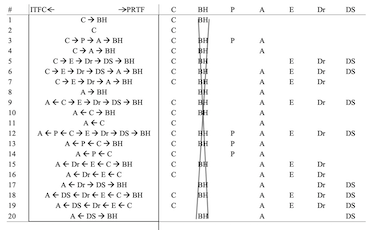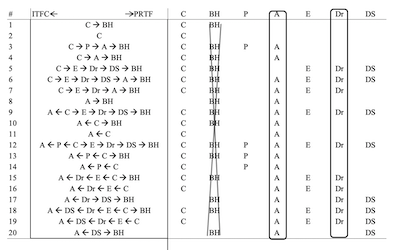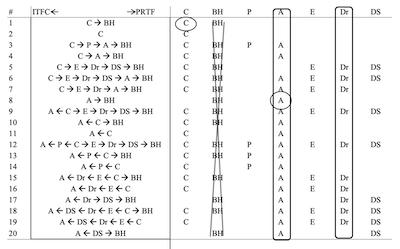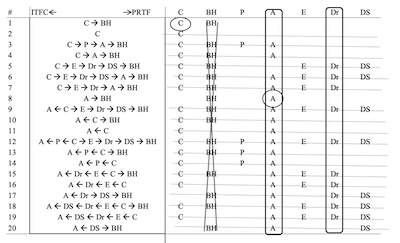The Grid rules are intended to identify the minimum set, which consists of confounders that could, if they were measured, be conditioned on (in regression) to estimate a causal effect.
A PDF summarizing these steps is available: ITFC Grid
The Grid rules are intended to identify the minimum set, which consists of confounders that could, if they were measured, be conditioned on (in regression) to estimate a causal effect.
A PDF summarizing these steps is available: ITFC Grid
 Using an “X” cross out any descendants of the exposure. Unless you are doing indirect effects analysis, conditioning on a descendant of the exposure will result in overcontrol bias and they should not be conditioned on.
Using an “X” cross out any descendants of the exposure. Unless you are doing indirect effects analysis, conditioning on a descendant of the exposure will result in overcontrol bias and they should not be conditioned on.
 Clearly identify any variables that are colliders, by putting a box around them. Colliders are variables where multiple directed edges terminate, e.g., they exhibit this pattern: > x <. Although colliders can be conditioned on, doing so can induce bias that will require additional adjustments, so it is ideal if the minimum set does not include colliders. If circumstances warrant adjusting for a collider, however, additional steps can be taken, which we address in a modified rule. See an example: Knowledge of End-of-Life Wishes DAG
Clearly identify any variables that are colliders, by putting a box around them. Colliders are variables where multiple directed edges terminate, e.g., they exhibit this pattern: > x <. Although colliders can be conditioned on, doing so can induce bias that will require additional adjustments, so it is ideal if the minimum set does not include colliders. If circumstances warrant adjusting for a collider, however, additional steps can be taken, which we address in a modified rule. See an example: Knowledge of End-of-Life Wishes DAG
 In this step we will begin identifying confounders for the minimum set. First, circle any confounders that are alone on their rows. These confounders must be in the minimum set given that they fully account for a backdoor path and no other variables are available for adjustment to block such a path. Note that this may include colliders. If there are no confounders alone on a row, look for pairs of confounders and circle them. Either of these variables must be in the minimum set. If there are no pairs, but there are groups of 3, circle them; and so forth. See an example: Knowledge of End-of-Life Wishes DAG
In this step we will begin identifying confounders for the minimum set. First, circle any confounders that are alone on their rows. These confounders must be in the minimum set given that they fully account for a backdoor path and no other variables are available for adjustment to block such a path. Note that this may include colliders. If there are no confounders alone on a row, look for pairs of confounders and circle them. Either of these variables must be in the minimum set. If there are no pairs, but there are groups of 3, circle them; and so forth. See an example: Knowledge of End-of-Life Wishes DAG
 Cross off any rows that include the single variables identified in Step III. Given that these variables must be included, they will block any path that they appear on. After this step is applied you may still have rows that are not crossed off. If that is the case, repeat steps III-IV, looking for pairs or higher numbered groupings of variables on the remaining rows. If there were no single variables and a pair was identified, you may be able to cross off any rows where this pair of variables appears. If either of these variables appears in a row without the other, a conditional approach may be needed. See an example of the conditional approach: PLC Grid
Cross off any rows that include the single variables identified in Step III. Given that these variables must be included, they will block any path that they appear on. After this step is applied you may still have rows that are not crossed off. If that is the case, repeat steps III-IV, looking for pairs or higher numbered groupings of variables on the remaining rows. If there were no single variables and a pair was identified, you may be able to cross off any rows where this pair of variables appears. If either of these variables appears in a row without the other, a conditional approach may be needed. See an example of the conditional approach: PLC Grid
After Steps I-IV have been applied, you should have one or more variables in your minimum set, which consists of the variables that are circled in each application of step III. This might include pairs of variables that were on the same row. In the case of pairs of variables, each one can be in a minimum set, which means that you will have one minimum set for each member of the pair. See an example: Knowledge of End-of-Life Wishes DAG
